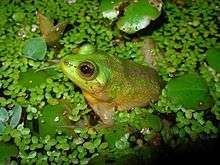Pseudis
| Pseudis | |
|---|---|
 | |
| Pseudis paradoxa | |
| Scientific classification | |
| Kingdom: | Animalia |
| Phylum: | Chordata |
| Class: | Amphibia |
| Order: | Anura |
| Family: | Hylidae |
| Subfamily: | Hylinae |
| Genus: | Pseudis Wagler, 1830 |
| Type species | |
| Rana paradoxa Linnaeus, 1758 | |
| Species | |
|
See text. | |
Pseudis is a genus of frogs (swimming frogs) in the Hylidae family, and are found in the Guianas, Colombia, Venezuela, Trinidad, Brazil, Paraguay, southeastern Peru, eastern Bolivia, northeastern Argentina, and Uruguay.[1]
Pseudis species are distributed throughout tropical and subtropical South America, almost entirely east of the Andes (P. paradoxa is the only species with population west of the Andes). They are commonly found in ponds associated with river floodplains, from Trinidad to northern Argentina, being absent only in Ecuador and Chile, highland regions, and the southernmost part of South America. Most species occur in Brazil, and P. fusca, P. tocantins, P. cardosoi, and P. bolbodactyla are endemic to this country.
Description
These frogs have several adaptations to aquatic life, such as protuberant eyes, robust hind limbs, and fully webbed feet.[2] Nevertheless, they belong to the "true" tree frogs, family Hylidae.[1]
These frogs are commonly known because their giant tadpoles can reach up to 26 cm (10 in).[3] They are closely related to a second genus, Lysapsus, that lacks giant tadpoles and in which adults are smaller, up to 2.4 cm (0.94 in), compared to up to 7.5 cm (3.0 in) in Pseudis.[2] Lysapsus has been considered a synonym of Pseudis, but molecular evidence support their separateness.[1]
Species
There are seven species in this genus (given that Lysapsus is accepted as a separate genus):[1]
| Binomial name and author | Common name |
|---|---|
| Pseudis bolbodactyla Lutz, 1925 | |
| Pseudis cardosoi Kwet, 2000 | |
| Pseudis fusca Garman, 1883 | |
| Pseudis minuta Günther, 1858 | lesser swimming frog |
| Pseudis paradoxa (Linnaeus, 1758) | paradoxical frog |
| Pseudis platensis Gallardo, 1961 | |
| Pseudis tocantins Caramaschi & Cruz, 1998 | |
Phylogenetic relationships
The phylogenetic position of frogs currently included in the genus Pseudis in relation to other anurans was for a long time a matter of debate. They have been placed in Ranidae, Leptodactylidae,[4] Hylidae,[5] and as their own family Pseudidae[6] This results from their highly derived body plan for a hylid frog due to their mostly aquatic habits. Recent morphological[7] and molecular[8] phylogenetic reconstructions have unambiguously placed them within the subfamily Hylinae with Scarthyla as a sister group.
Phylogenetic relationships among species of the group were recently proposed using molecular evidences.[2][9][7] Both publications found identical trees, but proposed different taxonomic solutions for the nonmonophyly of Pseudis, either resurrecting the genus Podonectes[2] or placing Lysapsus as a junior synonym of Pseudis.[9] More recent molecular evidence did not find Pseudis paraphyletic with respect to Lysapsus, so the synonymy is unnecessary.[1]
References
- 1 2 3 4 5 Frost, Darrel R. (2013). "Pseudis Wagler, 1830". Amphibian Species of the World 5.6, an Online Reference. American Museum of Natural History. Retrieved 11 December 2013.
- 1 2 3 4 GARDA, A. A., and D. C. CANNATELLA. 2007. Phylogeny and biogeography of paradoxical frogs (Anura, Hylidae, Pseudae) inferred from 12S and 16S mitochondrial DNA. Molecular Phylogenetics and Evolution. Molecular Phylogenetics and Evolution. 44:104-114.
- ↑ Emerson, S. B. (1988). "The giant tadpole of Pseudis paradoxa". Biological Journal of the Linnean Society. 34 (2): 93–104. doi:10.1111/j.1095-8312.1988.tb01951.x.
- ↑ NOBLE, G. K. 1922. The phylogeny of Salientia. I. The osteology and thigh musculature; their bearing on classification and phylogeny. Bulletin of the American Museum of Natural History. 46:1-87.
- ↑ PARKER, H. W. 1935. The frogs, lizards, and snakes of British Guiana. Proceedings of the Zoological Society of London. 505-530.
- ↑ SAVAGE, J. M., and A. L. DE CARVALHO. 1953. The family position of neotropical frogs currently referred to the genus Pseudis. Zoologica. 38:193-200.
- 1 2 DA SILVA, H. R. 1998. Phylogenetic relationships of the family Hylidae with emphasis on the relationships within the subfamily Hylinae (Amphibia: Anura). Department of Systematics and Ecology. University of Kansas.
- ↑ DARST, C. R., and D. C. CANNATELLA. 2004. Novel relationships among hyloid frogs inferred from 12S and 16S mitochondrial DNA sequences. Molecular Phylogenetics and Evolution. 31:462-475.
- 1 2 AGUIAR-JR., O., M. BACCI JR, A. P. LIMA, D. C. ROSSA-FERES, C. F. B. HADDAD, and S. M. RECCO-PIMENTEL. 2007. Phylogenetic relationships of Pseudis and Lysapsus (Anura, Hylidae, Hylinae) inferred from mitochondrial and nuclear gene sequences. Cladistics. 23:455-463.
External links
- Frost, Darrel R. (2013). "Pseudis Wagler, 1830". Amphibian Species of the World 5.6, an Online Reference. American Museum of Natural History.